Understanding Creatives in Advertising: Importance and Examples
In mobile gaming, how do you make your game stand out? The answer lies in your ad creatives. These are the first impression potential players have of your game, and they can make or break your user acquisition efforts. Without compelling creatives, even the best games can go unnoticed.
Effective ad creatives capture attention and convey the core aspects of the game. From a captivating video, an interactive playable ad, or a simple yet striking banner, the right creative can entice users to click and install. So, are you also struggling to attract new players despite investing in ads?
This blog explores the importance of ad creatives in mobile game user acquisition, showcases top-performing examples, and offers best practices to refine your ad strategies. Whether you're new to mobile game marketing or looking to refine your approach, understanding and implementing effective ad creatives is key to driving installs and growing your player base.
Why Do Ad Creatives Matter for User Acquisition?
Ad creatives play a crucial role in capturing the attention of potential players, making them the first interaction users have with a game. Well-designed ads can drive higher click-through rates (CTR) and conversion rates, resulting in more downloads and more engaged players. Here's why ad creatives are more crucial:
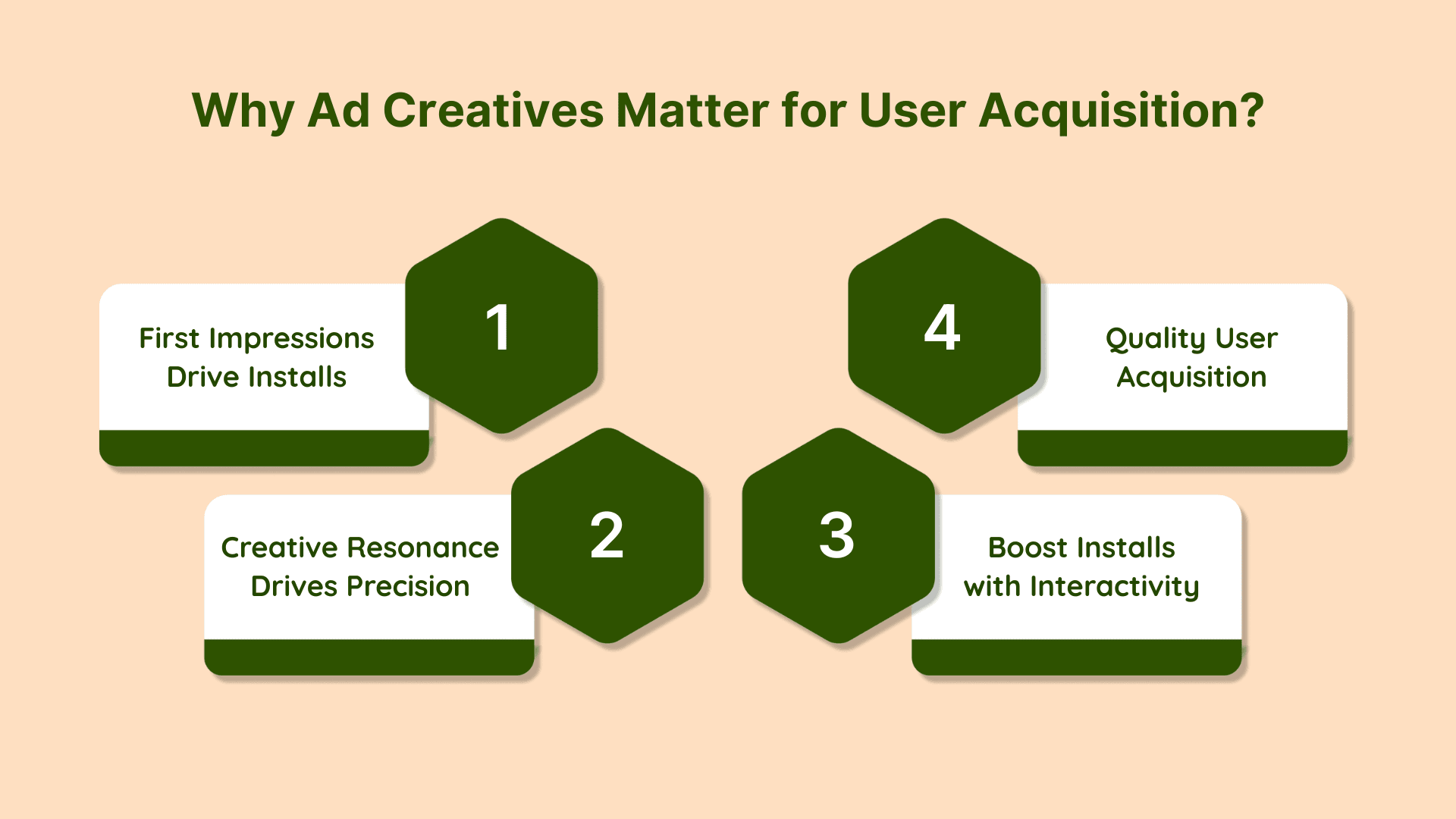
1. First Impressions Drive Installs: Ad creatives serve as the initial touchpoint between your game and potential players. A compelling ad can significantly increase the likelihood of a user installing your game, while a lackluster one may lead to missed opportunities.
2. Creative Resonance = UA’s Primary Lever: Since iOS 14+ and similar privacy shifts have limited IDFA-level targeting, ad platforms now rely on machine-learning signals, such as CTR, engagement duration, and play rate, to optimize delivery to high-intent users. Meta’s Advantage+ and other AI-driven suites continuously test and weigh assets based on these engagement metrics.
3. Enhanced Installs Through Interactive Formats: Interactive ad formats, such as playable ads, have gained popularity due to their ability to engage users actively. These formats enable potential players to experience a snippet of the game before installation, resulting in higher engagement and improved conversion rates.
4. Quality User Acquisition: Well-crafted ad creatives attract users and increase the chances that acquired users will engage with the game. By aligning ad content with the game's core experience, developers can attract users who resonate with the game's features, resulting in higher lifetime value.
Now that we understand why ad creatives are crucial for user acquisition, let’s explore the different creative elements that can make your ads more engaging.
Types of Creative Elements in Mobile Game Ads
Mobile game ads use various creative elements to capture attention and drive installs. These elements let you showcase the game’s features and attract potential players. Here are some of the elements:
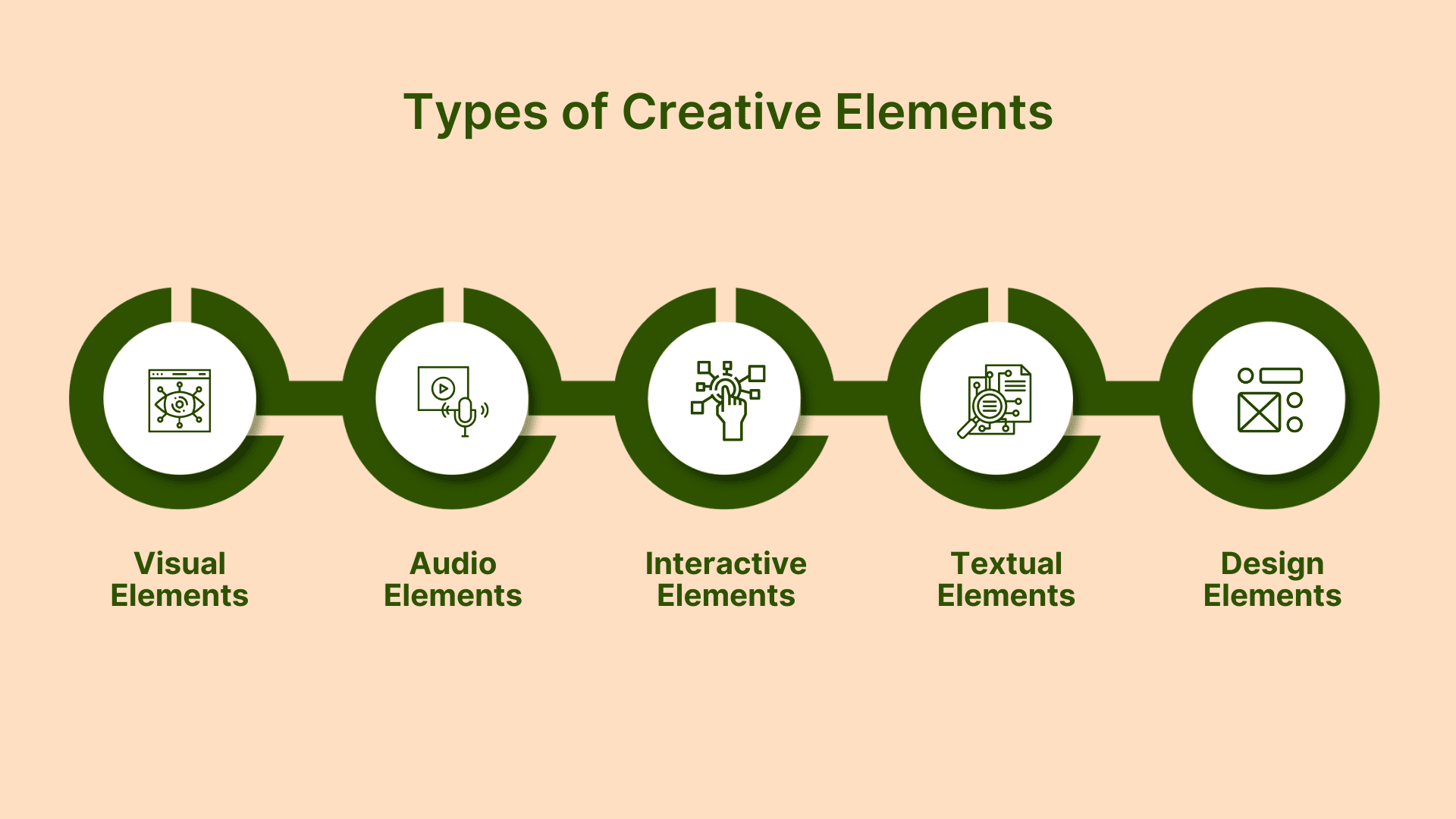
1. Visual Elements: High-quality visuals serve as the first impression of your game. They capture attention, convey the game's atmosphere, and can significantly increase click-through rates (CTR) and conversion rates. These elements include:
Images: High-quality static visuals showcasing key gameplay moments, characters, or features. These images serve as the first point of engagement, capturing the attention of potential users. Use 1080×1920 px (portrait) or 300×250 / 320×50 px (banner) with a clear focal point and keep file sizes ≤20 KB for fast load in-feed.
Videos: Short clips that highlight dynamic gameplay, storylines, or unique mechanics. These videos provide a glimpse into the game's experience, enticing users to download and play.
Animations: Dynamic visuals that illustrate game mechanics or features in an engaging way. Animations can simplify complex gameplay elements, making them more accessible to potential users.
Text Overlays: Captions that provide context, highlight features, or include calls to action. These overlays can guide users' understanding and prompt them to take desired actions, such as downloading the game.
2. Audio Elements: Audio elements enhance the immersive experience of the game, making ads more engaging. Well-crafted soundtracks and voiceovers can evoke emotions and create a connection with the audience, increasing the likelihood of conversion. These elements include:
Background Music: Soundtracks that set the tone and atmosphere of the game. Appropriate background music can evoke emotions and enhance the overall appeal of the game.
Voiceovers: Narration or character voices that explain gameplay or tell a story. Voiceovers can add personality to the game and make the experience more immersive for users.
3. Interactive Elements: Interactive elements enable potential users to engage directly with the game through the ad. This engagement can increase interest and drive higher conversion rates, as users can assess the game's appeal before downloading.. These elements include:
Playable Previews: These playable previews enable users to experience a snippet of the gameplay. Playable ads have been shown to increase user engagement and conversion rates significantly.
Swipeable Carousels: Interactive galleries showcasing different games. These carousels enable users to explore various aspects of the game, thereby increasing their interest and the likelihood of downloading.
Clickable Hotspots: Elements within ads that users can tap to learn more or take action. These hotspots can direct users to additional content or initiate the download process. Limit to 1–2 tappable areas with a minimum 44×44 dp touch target (per mobile UX guidelines) to maximize tap success.
4. Textual Elements: Textual elements provide clarity and context. They can highlight key features, convey the game's value proposition, and include calls to action that guide users toward the desired behavior. These elements include:
Headlines: Attention-grabbing statements that pique interest. Effective headlines can draw users in and encourage them to engage with the ad.
Subheadings: Supporting text that provides additional information or context. Subheadings can elaborate on the game's features or storyline, providing users with more reasons to download.
Calls to Action (CTAs): Directives like "Play Now," "Download," or "Learn More" that encourage user interaction. Clear and compelling CTAs can significantly increase conversion rates by guiding users toward the desired action.
5. Design Elements: Well-thought-out design elements ensure that the ad is visually appealing, easy to understand, and aligned with the game's branding. Consistent and professional design can build trust and improve user experience, leading to higher conversion rates. These elements include:
Color Schemes: The use of colors that align with the game's branding and evoke desired emotions. Consistent and thoughtful color choices can enhance game appeal.
Typography: Fonts that are legible and match the game's theme. Appropriate typography ensures readability and reinforces the game's aesthetic.
Layout: The arrangement of elements to ensure clarity and focus on key aspects. A well-organized layout guides users' attention and improves the overall user experience.
Now that we've covered the key creative elements, let's explore the various ad formats used to showcase them effectively in mobile game advertising.
Also Read: Why Your Creatives (Not Audiences) Are the Real Targeting Lever in 2025
Types of Ad Creative Formats in Mobile Games
Mobile game ads come in various formats, each designed to capture user attention and encourage installs. These formats include interactive, video, and static ads, each offering unique benefits for user acquisition. Here are some of the most effective ad creative formats:
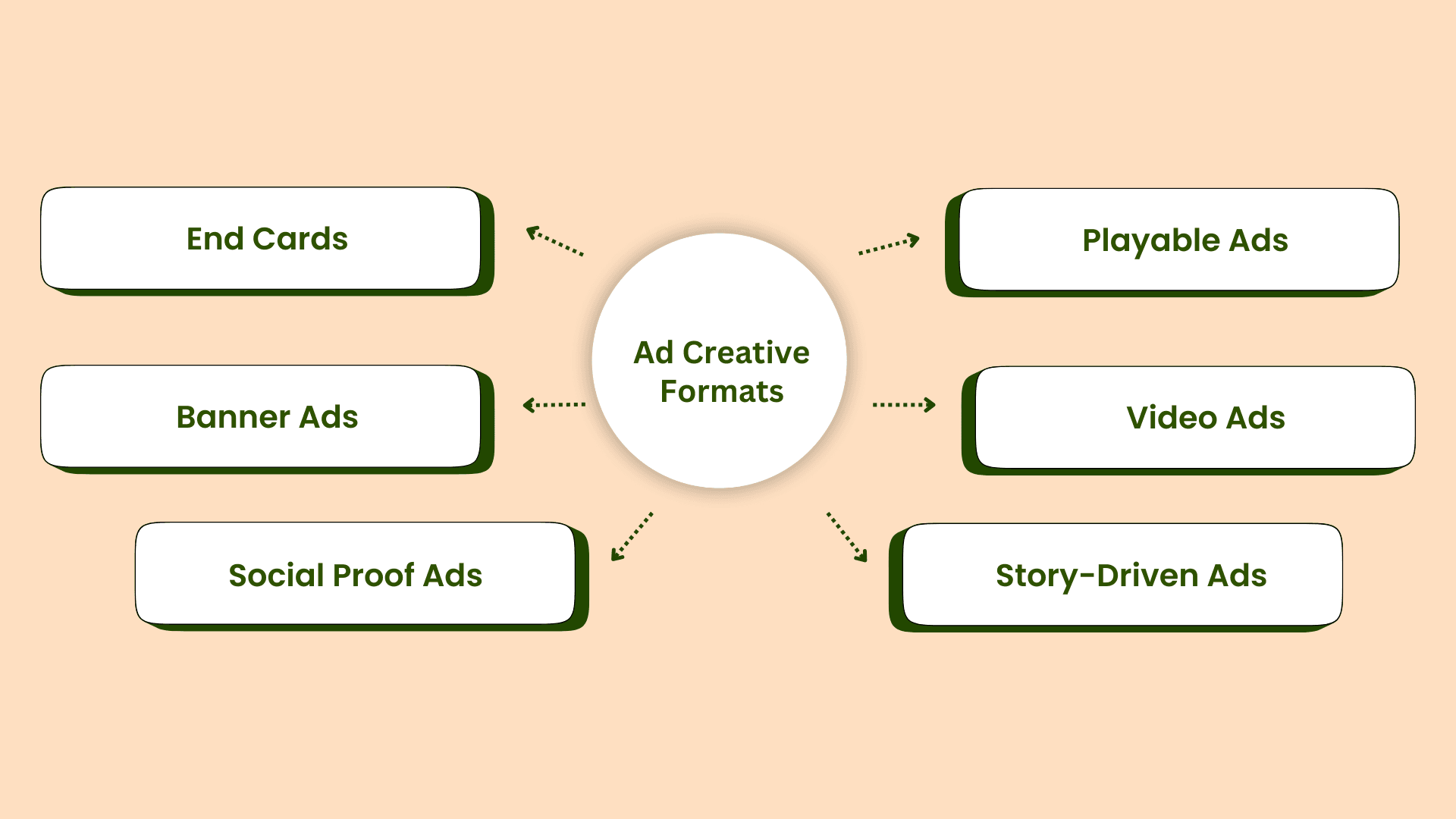
1. Playable Ads
Playable ads are interactive mini-games embedded within advertisements, enabling users to experience a snippet of the actual gameplay before installation. This format enables potential players to assess the game's mechanics and appeal firsthand. By letting users experience the gameplay firsthand, playable ads ensure that only genuinely interested users install the game, leading to higher-quality installs.
To further enhance your playable ad strategy, consider using Segwise's free Video to Playable Ad Converter. This tool enables you to convert existing MP4 video ads into playable HTML embeds compatible with networks such as AppLovin and Mintegral. It's a no-code solution that simplifies the process of creating engaging playable ads.
Benefits
High Engagement: Users interact directly with the game, leading to increased interest.
Pre-qualification: Potential players can evaluate the game's appeal, reducing post-installation churn.
Enhanced Conversion Rates: Interactive experiences often lead to higher download rates.
Best For
Casual and hyper-casual games with straightforward mechanics.
Example
https://drive.google.com/file/d/1-vQx3xD2BrR2vTXOulO-Sqhyjn59K7u3/view?usp=drive_link
“https://youtu.be/2B8LWoDLnXo?feature=shared”
Royal Match, A match-3 puzzle game by Dream Games, has successfully utilized playable ads to showcase its core gameplay, leading to significant user acquisition.
2. Video Ads
Short videos that highlight key gameplay features, narratives, or unique mechanics. They serve as dynamic showcases of the game's experience, providing potential users with a visual and auditory preview. A well-crafted video that clearly demonstrates the value proposition of the game can lead to more downloads
Benefits
Effective Storytelling: Conveys the game's atmosphere and mechanics succinctly.
High CTR: Engaging content often results in higher click-through rates.
Wide Reach: Easily shareable across various platforms, increasing visibility.
Best For
Games with rich visuals or to showcase actual gameplay.
Example
https://drive.google.com/file/d/1Vd1nRfYMWpKd83HkbDGXNmpvs6F6m-HE/view?usp=drive_link
“https://youtu.be/kxx6DXy7x2k?feature=shared”
Merge Mansion is known for its dramatic and intriguing video ads that have gone viral. This ad exemplifies how Merge Mansion combines dramatic storytelling with gameplay mechanics to engage potential players and encourage game downloads.
3. Story-Driven Ads
Story-driven advertisements that tell a short, engaging story or showcase character development to create an emotional connection. They aim to intrigue potential players by presenting a narrative snippet. Story-driven ads connect with both new users and brand loyalists.
Benefits
Emotional Engagement: Builds anticipation and interest, especially for narrative-driven games.
Brand Recall: Memorable stories enhance brand recognition.
User Connection: Potential players can relate to characters or scenarios, increasing the likelihood of installation.
Best For
Role-playing games (RPGs) and adventure games.
Example
https://drive.google.com/file/d/1q0oOopgorq6mza5jv_y0lNr1V2f8RzEw/view?usp=drive_link
“https://www.youtube.com/shorts/L1k5NDQJ7rc?feature=share”
AFK Journey employs story-driven ads to entice users by showcasing character choices and consequences. The game features a rich narrative, immersive environments, and characters, offering an engaging storyline alongside strategic gameplay.
4. Social Proof Ads
Ads that include testimonials, user reviews, influencer endorsements, or user-generated content (UGC) help build trust by showing that others enjoy the game. Using social proof in your ads boosts credibility and encourages more people to install the game.
Benefits
Enhanced Trust: Builds credibility and encourages installs through social validation.
Influencer Impact: Endorsements from popular figures can sway decisions.
Community Building: Highlights a game's active community, attracting like-minded users.
Best For
Games with strong community support or influencer partnerships.
Example
https://drive.google.com/file/d/15SHYOu326ggsdnKLLrbXoNLkYEmg1-IC/view?usp=drive_link
“https://www.youtube.com/shorts/TZqQ67mnwXo?feature=share”
Subway Surfers incorporates user testimonials and influencer endorsements in its ads to build credibility.
5. Banner Ads
These are static or animated images displayed at the top or bottom of the screen within other apps or games. They serve as unobtrusive reminders or invitations to try the game, often prompting users to take action. Banner ads can drive user acquisition by letting you target the right audience, attract players, and increase engagement.
Benefits
Consistent Visibility: Provides regular exposure to potential players..
Cost-Effective: Often more affordable compared to other ad formats.
Targeted Reach: Can be strategically placed to reach a specific user segment.
Best For
Games with high daily active users (DAUs) and low user acquisition costs.
Example
Supercell effectively utilized banner ads to promote Clash Royale within Clash of Clans, targeting existing players to try the new game. This cross-promotion strategy leveraged the high daily active users (DAUs) of Clash of Clans to introduce Clash Royale to a relevant audience, thereby enhancing user acquisition.
6. End Cards
The final step, known as the end card, plays a crucial role in optimizing user acquisition campaigns. This component showcases a call to action, strategically placed either throughout the advertisement or exclusively at the end, aimed at motivating players to download the mobile game. They direct users to take the desired action immediately after viewing the ad.
Benefits
Clear Direction: Guides users on the next steps, reducing friction.
Immediate Action: Encourages prompt installations or interactions.
Enhanced Conversion: Well-designed end cards can significantly boost conversion rates.
Best For
All ad formats, especially video and playable ads.
Example
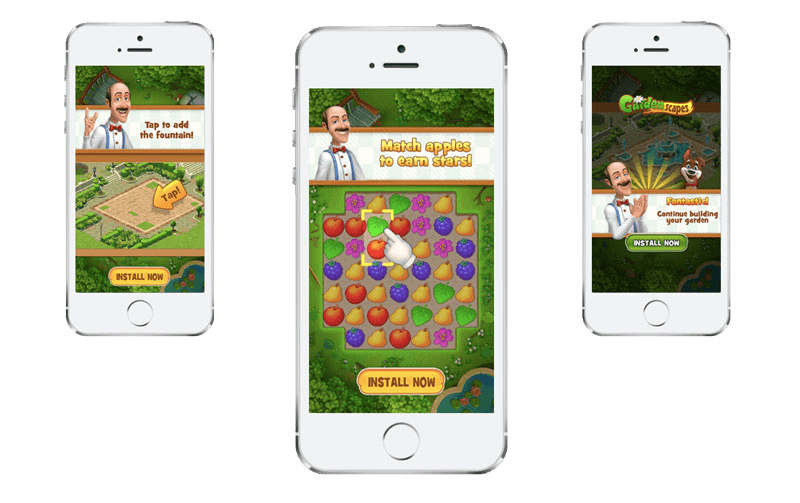
Gardenscapes Playable Ad with End Card concludes with a screen prompting users to install the game.
Now that we've explored the various ad creative formats, let's explore some real-world examples to see how these creatives drive user acquisition.
Case Studies
Real-world examples highlight the effectiveness of different strategies in attracting and engaging players. Here are some successful case studies that showcase how various ad creative formats have been used to drive user acquisition in mobile games.
1. Royal Match – Mastering User Acquisition Through Creative Advertising
Overview: Royal Match is a free-to-play match-3 puzzle game where players assist King Robert in restoring his royal castle by completing levels and earning stars to decorate various rooms.
Challenge: In the mobile gaming industry, where 80% of games fail within a year, Royal Match aimed not only to survive but also to thrive. The challenge was to stand out among numerous match-3 games and establish a strong user base.
Strategy: Dream Games implemented a multifaceted advertising strategy that combined psychological triggers, authentic content, and interactive elements:
Street Interview Hook: The ads began with real-life street interviews where individuals casually mentioned that Royal Match is "free to play" and "no Wi-Fi required," addressing common concerns about mobile game accessibility.
Failure Gameplay Clips: Incorporating intentionally failed game clips tapped into viewers' desire for challenge and control, prompting them to engage with the game to overcome the presented obstacles.
Playable Ads: Seamlessly transitioning into playable ads allowed users to experience the game's mechanics firsthand without downloading, enhancing trust and providing immediate feedback.
High Volume of Creatives: Deploying over 1,800 daily creatives avoids audience fatigue and keeps the content fresh and engaging.
This integrated approach effectively guided potential players through a journey of curiosity, trust, emotional engagement, and action.
Results: The strategic advertising efforts led to significant outcomes:
Impressive Download Numbers: Achieved 86 million downloads in the past year.
Substantial Revenue: Generated $73 million in revenue.
High User Ratings: Maintained an average rating of 4.6/5 on Google Play and 4.7/5 on the Apple App Store, reflecting strong user satisfaction.
2: Leveraging Banner Ads for User Acquisition in Mobile Gaming
The case study explores how mobile game developers can use banner ads, particularly through cross-promotion, to drive user acquisition. It emphasizes the growing importance of engaging ad formats that don't disrupt gameplay.
SuperSonic Studios Cross-Promotion Strategy: SuperSonic Studios effectively places video banner ads on the opening screens of their games to showcase other titles within their portfolio. This seamless cross-promotion approach introduces players to more games and increases the chance of cross-engagement.
Result: By adopting these ads, mobile game developers can effectively promote their games, increasing user acquisition and enhancing player engagement.
Now that we've explored some successful examples, let's explore the best practices that will let you design compelling ad creatives.
Best Practices for Designing Effective Ad Creatives
Creating good ads is crucial for attracting players to your mobile game. Below are some simple yet effective ways to design your ads for better user acquisition:
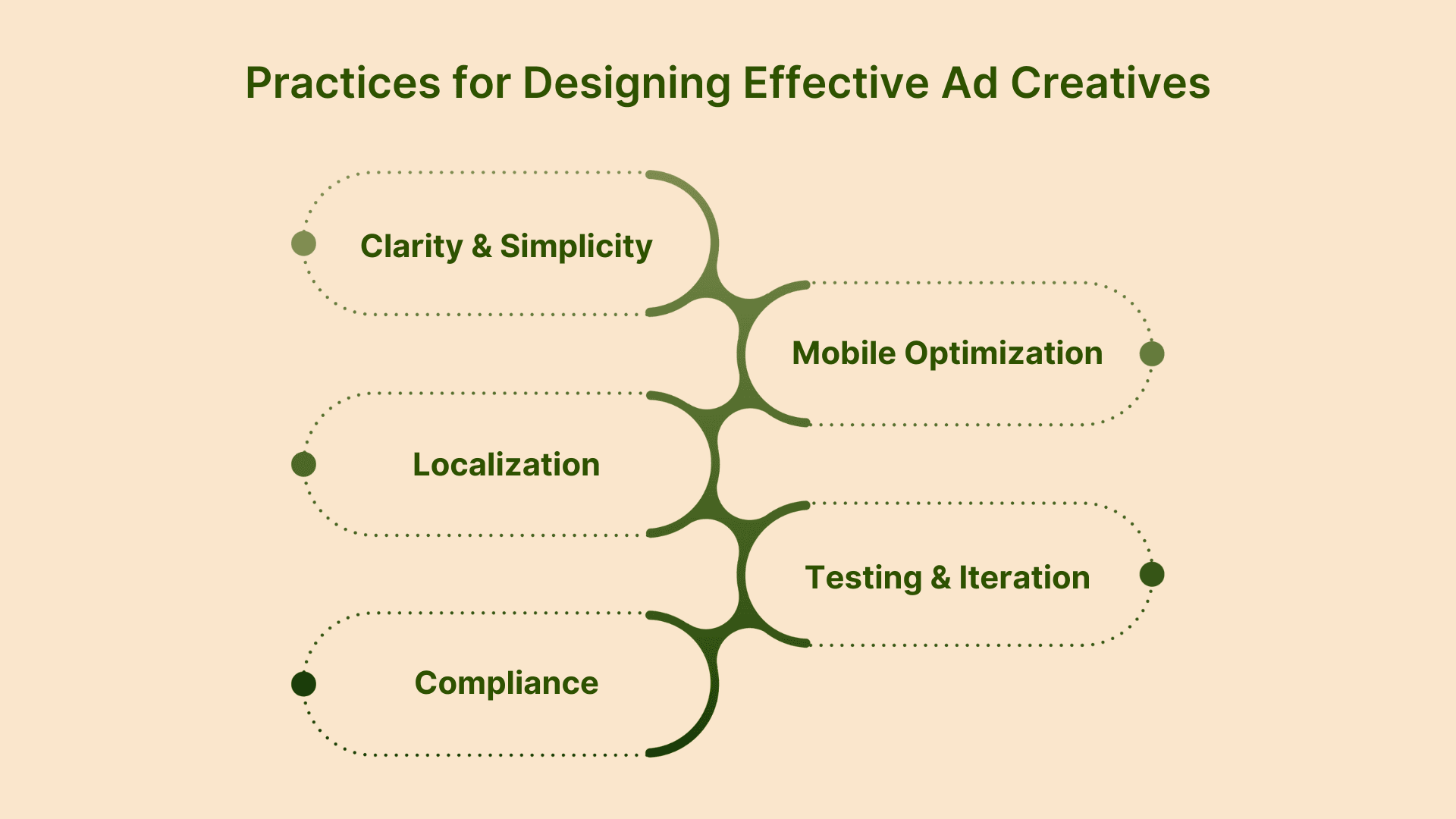
Clarity and Simplicity: Focus on delivering a clear message without clutter. Keep the text concise and use clear visuals that showcase the game's core features to engage users quickly.
Mobile Optimization: Ensure your ads are optimized for mobile screens. They should load quickly and display correctly on various devices, providing a smooth user experience.
Localization: Tailor your ads to different regions and languages to make them more relatable. Adjust the visuals, text, and themes to fit local preferences and cultural nuances.
Testing and Iteration: Testing enables you to determine which ads are most effective. By changing a few things in your ad, you can improve its performance and get more installs. To improve your ads, perform continuous testing:
A/B Testing: Compare different versions of ads to determine what works best. For example, try changing the title or image to see which one generates more clicks.
Multivariate Testing: If you want to test a few things, like colors or CTA buttons, do it all at once to get better results.
Compliance: Ensure your ads follow platform guidelines and avoid misleading content. Ensure that you respect user privacy and comply with legal regulations to maintain a smooth ad experience.
Also Read: A Beginner's Guide to A/B Testing Ads for Optimization
Conclusion
Effective ad creatives are pivotal in mobile game user acquisition. By capturing attention and conveying the game's core aspects, they serve as the first impression potential players have. The right creative can entice users to click and install your game. So, understanding and implementing effective ad creatives is key to growing your player base.
To further optimize your ad creatives, consider using Segwise, an AI-powered platform designed to simplify creative analytics and insights. Segwise's Creative AI Agent automatically tags and analyzes creative elements, providing actionable insights to enhance ad performance.. With its custom dashboard, you can create custom reports on aggregated creative data from across ad networks to always know your top creatives.
So, are you ready to enhance your user acquisition strategy? Start your journey today by signing up for a 14-day free trial and see how Segwise can transform your ad creatives and drive better results for your mobile game.
FAQs
1. Can user-generated content (UGC) be effective in ad creatives?
Yes, UGC can enhance credibility and relatability. Incorporating real user experiences or testimonials can build trust and encourage potential players to install the game.
2. How can I stay updated with the latest trends in mobile game ad creatives?
Regularly follow industry blogs, attend webinars, and participate in forums dedicated to mobile game marketing. Engaging with the community and staying informed about new tools and strategies can help you adapt to evolving trends.
3. How can I track the performance of my ad creatives?
Utilize analytics tools provided by ad platforms or third-party services to monitor key metrics such as click-through rates, conversion rates, and cost per install. Regularly reviewing these metrics can help identify successful creatives and areas for improvement.
Comments
Your comment has been submitted successfully!